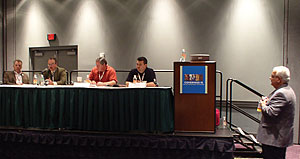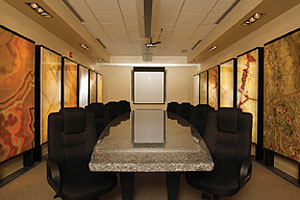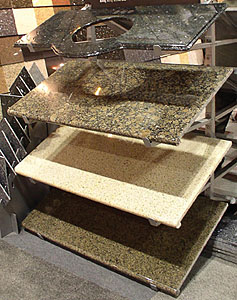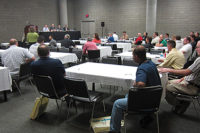
As a result of the changing economic climate, Fabricator Forums at industry events such as Coverings have been more focused on sales, marketing and “general business” issues as opposed to fabrication and installation techniques.
In general, the education program at stone trade shows such as Coverings will include a “Fabricator Forum,” where attendees discuss current issues with a panel of industry experts. Historically, these sessions have focused on practical concerns, such as fabrication methods and installation challenges. Over the past few years, however, these sessions have begun to lean towards the “business” of operating a fabrication shop, and this was apparent at a forum that featured a panel several industry veterans, including:
• Guido Gliori, Grazzini Brothers & Co., Mendota Heights, MN
• Brett Rugo, Rugo Stone, Lorton, VA
• Michael Twiss, Columbia Stone, Inc., Tualatine, OR
• Rafael Bernal, Great Lakes Granite & Marble Co., Redford, MI
• G.K. Naquin, Stone Interiors, Loxley, AL (moderator)
The following is a summary of the topics that were discussed:
How has your marketing changed in recent times?
Gliori:Grazzini Brothers is 85% commercial, and we have redefined who our customers are. When we saw a drop in sales, I was surprised it dropped that drastically. We were not selling to homebuilders and contractors anymore, so our marketing strategy drastically changed. We became “construction guys” selling to homeowners, and there was a new mentality.
Bernal:We are seeing the same challenges, and we are mostly doing residential work. Some people feel the Internet is it right now. That’s how they get their hotel rooms, their flights, etc.
Everyone has gone onto Google and seen the sponsored links. We decided to immerse ourselves in that. The ROI [return on investment] is higher than the Yellow Pages or a local magazine. You really want to position your company within the first two or three links of a Google search.
Twiss:We hired an outside marketing firm, and they told us to stop doing mass mailings. They only work in a good economy, and the return is only 2% or even a loss.
We reached out to the design community, and we became a trainer for architects, providing CEUs. We also got involved in online marketing, but my concern is that everyone is busy on Twitter and Facebook, they may lose focus on their “regular job.”
Rugo:We are also on Social Media -- YouTube, Facebook, etc. I think they are useful, but you have to be careful that they aren’t overused, and suddenly everyone is sitting on Facebook all day long.
Also, most of our work is commercial, so we aren’t marketing to the masses. We take photos of our completed work and create professional marketing pieces to re-confirm our position in the marketplace.
I still believe in using printed materials, though, and we design high-end printed materials to remain relevant.

A range of sales, marketing and business topics were discussed at a forum led by a panel of industry veterans, including (from left): Guido Gliori of Grazzini Brothers & Co. in Mendota Heights, MN; Brett Rugo of Rugo Stone in Lorton, VA; Michael Twiss of Columbia Stone, Inc. in Tualatine, OR; Rafael Bernal of Great Lakes Granite & Marble Co. in Redford, MI; and G.K. Naquin of Stone Interiors in Loxley, AL (moderator).
The market has changed a lot since 2007, but now we are picking up market share. We know it is a finite market with a decreased price structure, so for us, we knew we had to claim market share.
Do these marketing techniques replace the need for outside sales?
Twiss:We don’t really have salespeople. We have marketing people. Our builder customers aren’t sitting on computers looking at Facebook. You have to go out and see them.
We aren’t “order takers” anymore. You have to go out and make contact.
Bernal:We are looking for outside sales help, but the majority of people you talk to want the company to pay for their car, their credit card and everything else. We want the pay to be in the results they bring, but it is hard to drum up business now. Maybe we could do something that wasn’t a 100% commission base, but tiered compensation. It has worked in other industries.
Are people working more with builder clients?
Twiss:On the residential side, we are moving away from pure retail. We prefer to work with larger builders that have an office; not the pick-up truck guys where we end up spending hours with a homeowner looking at remnants. Once the builder relationship is established, you will get repeat business. They want someone they can trust.
Naquin:Our dealer base in the Gulf Region is shrinking. We are promoting our name to more builders now.
What about in the showrooms? Are you using flat panel televisions and digital technology?
Twiss:Yes, but that is geared as a service for the clients that builders send in. Something as simple as adding the word “Countertops” over our sign that said “Columbia Stone” helped people understand what we do. We also make sure to keep our blinds open so that people can see inside and know that we are open for business.
Bernal:We deal with Big Box retailers and cabinet shops. We have walk-in customers, and for us, the most important thing is to make sure they are educated and they know what to expect.
Naquin:We have flat-screens in our showrooms. We can click on jobs with different materials, different edges, etc. They are categorized so that the sales people can show examples of various jobs that we have completed. It is amazing to see how many people will change their initial choices once they have seen the alternatives.
How do you get people to come to your showroom as opposed to visiting them?
Bernal:For us, offering samples is a draw. People are more likely to come if they know they can take something away.

Fabricators are becoming more sophisticated in the use of technology within their showrooms, using video and digital imaging as well as actual stone displays.
John Cogswell, Cogswell Stone, Palmyra, VA (audience member): We began visiting homes to try and get people excited if they are within a reasonable driving distance. We sell service, if we can show it up front, it helps.
Naquin:If we go out and visit someone, that means we have qualified the customer. You might be wrong 10% of the time, but that is better than running out every time someone calls.
How are you able to negotiate with the Big Box retailers?
Naquin:They are national and they are regional. They will tell you what to do, what to charge, etc. You can gain some leverage based on how many stores you do. You negotiate within the range that they do with other fabricators.
Once you are in, you stay in as along as you don’t mess up and get complaints. But you need to understand that you aren’t going to do it your way. You work within their system and their paperwork, but they can be profitable and they pay on time. They have kept us in business.
Do you have different price structures for different customers?
Rugo:In our case, we have one price structure for all of our clients.
Twiss:We used to have builder pricing versus retail pricing, but all of that went away. We don’t want to lose a job because we didn’t give the best reasonable price.
Bernal:Everyone is looking at price right now. We want to make sure our designer clients understand why the costs are what thy are.
How do you motivate your employees? Does anyone pay workers by the amount of square feet produced?
Gliori:We are in Minnesota, and Grazzini is a union company, but we have cut ties with the union in the shop. Our wages in the shop are steady -- $15 to 20 per hour to start. But their overall employment is based on the quality of work and how much they work. We track the performance of each employee so we know what we need to do.
Rugo:Incentive programs can be tough. We had 270 people working for us five years ago. Now we have 70. We have employed as many as 600 people over the years. We learned not to steal employees from other people, but to “breed” our own employees. We want to develop mentors who believe in the business.
You cannot operate a workplace with a revolving door. Have a foreman who is the centerpiece of your operation, but don’t forget that you are the owner.
Twiss:We are union in the field, but not in the shop. Around 80% of our shop workers have been with us for 10 years or more. As far as an incentive program, when you look at what a slab costs, you don’t want your workers saying, “How fast do I have to cut that to make my quota?” Your repair and service costs have to stay low. We aren’t a huge-volume shop, so it works for us.
Bernal:We have been in a [production] compensation plan for two years. It is a challenge, but we try and make sure it is not just the amount of work being done, but also the quality. We have had to make adjustments, but we also saw that our saw production increased while fabrication costs decreased.

The use of pre-fabricated “blanks” from overseas was debated among forum attendees. “We have worked with precuts for condominium work, but it is not the clients that we are all accustomed to,” Naquin said. “We are professionals, not subbers doing a commodity.”
Naquin: We have two facilities. One pays by the square foot and the other pays an hourly rate. In Alabama, our shop pays an hourly rate, but the pay has come down. In South Carolina, we pay by the square foot, but we still have to maintain an hourly minimum by law.
What is the formula for profit in a shop? Where should profits be?
Rugo: Well, obviously it has to be more than the prevailing interest rate. If we’re not running at 8 to 10% profit, then it is not viable.
Twiss: A Marble Institute of America survey listed the average profit at 3 ½% in 2009, which as very low.
Naquin: The national average of all industries was at 3%.
Are people using software to track their inventory?
Gliori: Only 15% of our business is residential. We have cut our inventory way back over the last five years, since there are four stoneyards in our immediate area. We track material with an Excel spreadsheet. You have to keep updating it, though. It takes diligence.
Twiss: We also don’t have a huge inventory. We assign each slab a number, and we note the cost, and we track everything on Excel.
What are people doing with their remnants? Are they selling them on the Internet? Does selling your remnants encourage “garage fabricators?”
Bernal: Those garage shops will always exist. Some people will want that because of price, but others will do their research and decide they want a legitimate shop.
Naquin: If you offer the material as a vanity, for example, pre-cut slabs can add value to a ticket.
How many people are working with pre-fabricated slabs (blanks) from overseas?
Rugo: You need to know your market, and that’s not a market for us. We have used remnants from cladding jobs as vanities, but we don’t use blanks.
Twiss: We once bought half a container, but it’s really not our market. Plenty of people do it, but we’re not chasing that market. We pursue high-end work with designers.
Bernal: We also brought in half a container, but we ended up re-polishing it, and when you factor in the cutting and everything else, the numbers didn’t work.
Naquin: The market for blanks is large. We have worked with pre-cuts for condominium work, but it is not the clients that we are all accustomed to. We are professionals, not subbers doing a commodity.
Are more fabricators working with engineered stone/quartz surfacing?
Twiss: It is a necessity now. If you are in the countertop business, you have to be willing to do all surfaces.
Naquin: We are even offering Corian through a subcontractor.
Bernal: Some speakers have said that 10% of your business will change each year. We started with granite, then engineered stone, and now people are even asking for wood. If you are unwilling to change, then someone else will. You have to know what is out there.
What is the formula for profit in a shop? Where should profits be?
Rugo: Well, obviously it has to be more than the prevailing interest rate. If we’re not running at 8 to 10% profit, then it is not viable.
Twiss: A Marble Institute of America survey listed the average profit at 3 ½% in 2009, which as very low.
Naquin: The national average of all industries was at 3%.
Are people using software to track their inventory?
Gliori: Only 15% of our business is residential. We have cut our inventory way back over the last five years, since there are four stoneyards in our immediate area. We track material with an Excel spreadsheet. You have to keep updating it, though. It takes diligence.
Twiss: We also don’t have a huge inventory. We assign each slab a number, and we note the cost, and we track everything on Excel.
What are people doing with their remnants? Are they selling them on the Internet? Does selling your remnants encourage “garage fabricators?”
Bernal: Those garage shops will always exist. Some people will want that because of price, but others will do their research and decide they want a legitimate shop.
Naquin: If you offer the material as a vanity, for example, pre-cut slabs can add value to a ticket.
How many people are working with pre-fabricated slabs (blanks) from overseas?
Rugo: You need to know your market, and that’s not a market for us. We have used remnants from cladding jobs as vanities, but we don’t use blanks.
Twiss: We once bought half a container, but it’s really not our market. Plenty of people do it, but we’re not chasing that market. We pursue high-end work with designers.
Bernal: We also brought in half a container, but we ended up re-polishing it, and when you factor in the cutting and everything else, the numbers didn’t work.
Naquin: The market for blanks is large. We have worked with pre-cuts for condominium work, but it is not the clients that we are all accustomed to. We are professionals, not subbers doing a commodity.
Are more fabricators working with engineered stone/quartz surfacing?
Twiss: It is a necessity now. If you are in the countertop business, you have to be willing to do all surfaces.
Naquin: We are even offering Corian through a subcontractor.
Bernal: Some speakers have said that 10% of your business will change each year. We started with granite, then engineered stone, and now people are even asking for wood. If you are unwilling to change, then someone else will. You have to know what is out there.
